Quality Management: Overview, Champions, and Implementing Quality
VerifiedAdded on 2020/12/04
|63
|15543
|256
Report
AI Summary
This report provides a comprehensive overview of quality management, starting with a personal definition of quality and exploring the two categories of customers within an organization, internal and external, as well as financial expectations. It discusses the criteria for 'doing things right', the process and advantages of benchmarking, and the concept of a learning organization. The report further delves into the positive results of managing for quality, Deming's 14 Obligations of Top Management, the Malcolm Baldrige National Quality Award, and Six Sigma applications in the hospitality industry. It also highlights common themes among quality gurus and the importance of cross-functional teams and strategic quality planning. The report emphasizes the importance of customer-driven organizations, continuous quality improvement, and the historical context of quality management, including the contributions of key quality leaders like Deming, Juran, and Ishikawa.
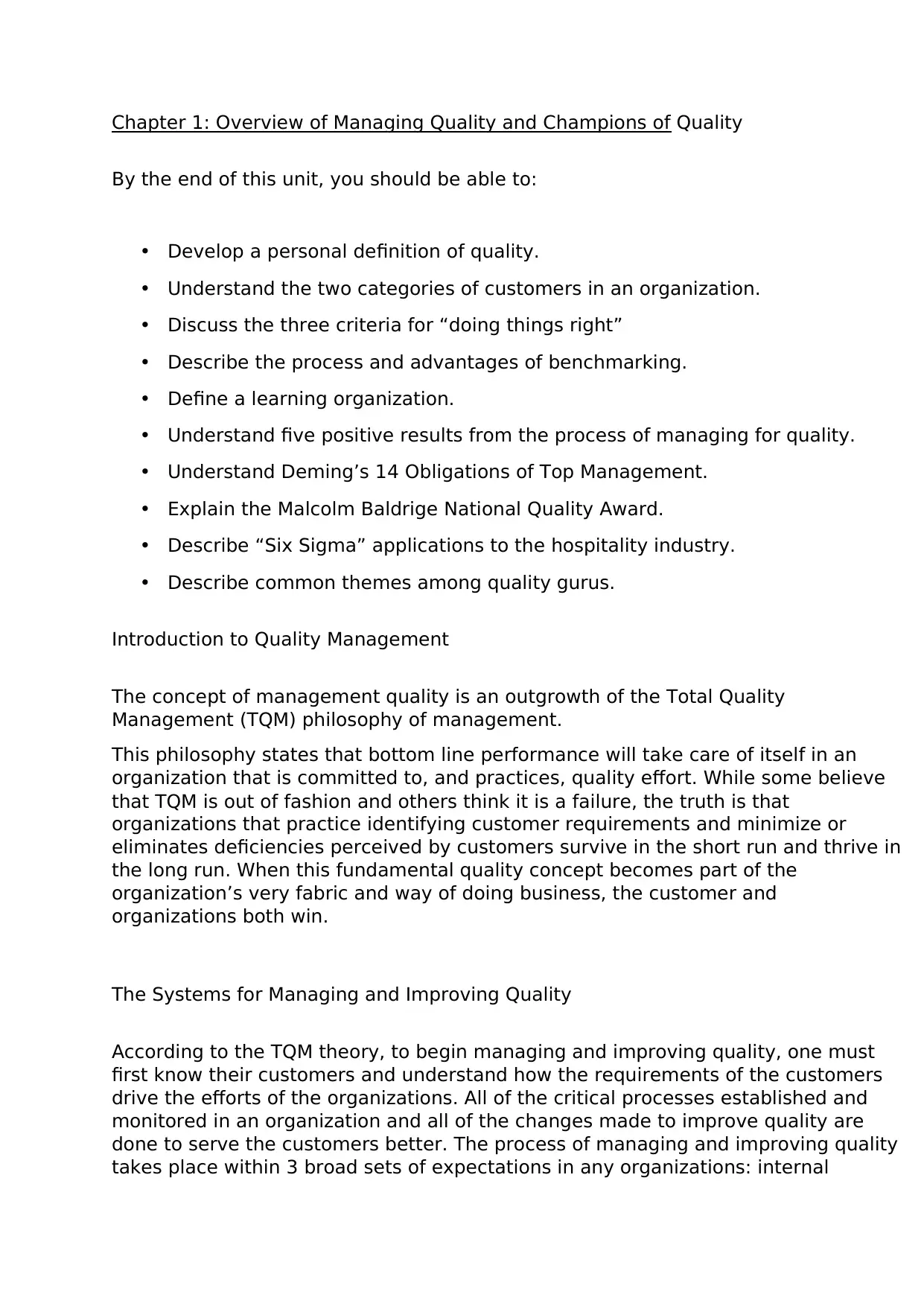
Chapter 1: Overview of Managing Quality and Champions of Quality
By the end of this unit, you should be able to:
• Develop a personal definition of quality.
• Understand the two categories of customers in an organization.
• Discuss the three criteria for “doing things right”
• Describe the process and advantages of benchmarking.
• Define a learning organization.
• Understand five positive results from the process of managing for quality.
• Understand Deming’s 14 Obligations of Top Management.
• Explain the Malcolm Baldrige National Quality Award.
• Describe “Six Sigma” applications to the hospitality industry.
• Describe common themes among quality gurus.
Introduction to Quality Management
The concept of management quality is an outgrowth of the Total Quality
Management (TQM) philosophy of management.
This philosophy states that bottom line performance will take care of itself in an
organization that is committed to, and practices, quality effort. While some believe
that TQM is out of fashion and others think it is a failure, the truth is that
organizations that practice identifying customer requirements and minimize or
eliminates deficiencies perceived by customers survive in the short run and thrive in
the long run. When this fundamental quality concept becomes part of the
organization’s very fabric and way of doing business, the customer and
organizations both win.
The Systems for Managing and Improving Quality
According to the TQM theory, to begin managing and improving quality, one must
first know their customers and understand how the requirements of the customers
drive the efforts of the organizations. All of the critical processes established and
monitored in an organization and all of the changes made to improve quality are
done to serve the customers better. The process of managing and improving quality
takes place within 3 broad sets of expectations in any organizations: internal
By the end of this unit, you should be able to:
• Develop a personal definition of quality.
• Understand the two categories of customers in an organization.
• Discuss the three criteria for “doing things right”
• Describe the process and advantages of benchmarking.
• Define a learning organization.
• Understand five positive results from the process of managing for quality.
• Understand Deming’s 14 Obligations of Top Management.
• Explain the Malcolm Baldrige National Quality Award.
• Describe “Six Sigma” applications to the hospitality industry.
• Describe common themes among quality gurus.
Introduction to Quality Management
The concept of management quality is an outgrowth of the Total Quality
Management (TQM) philosophy of management.
This philosophy states that bottom line performance will take care of itself in an
organization that is committed to, and practices, quality effort. While some believe
that TQM is out of fashion and others think it is a failure, the truth is that
organizations that practice identifying customer requirements and minimize or
eliminates deficiencies perceived by customers survive in the short run and thrive in
the long run. When this fundamental quality concept becomes part of the
organization’s very fabric and way of doing business, the customer and
organizations both win.
The Systems for Managing and Improving Quality
According to the TQM theory, to begin managing and improving quality, one must
first know their customers and understand how the requirements of the customers
drive the efforts of the organizations. All of the critical processes established and
monitored in an organization and all of the changes made to improve quality are
done to serve the customers better. The process of managing and improving quality
takes place within 3 broad sets of expectations in any organizations: internal
Paraphrase This Document
Need a fresh take? Get an instant paraphrase of this document with our AI Paraphraser
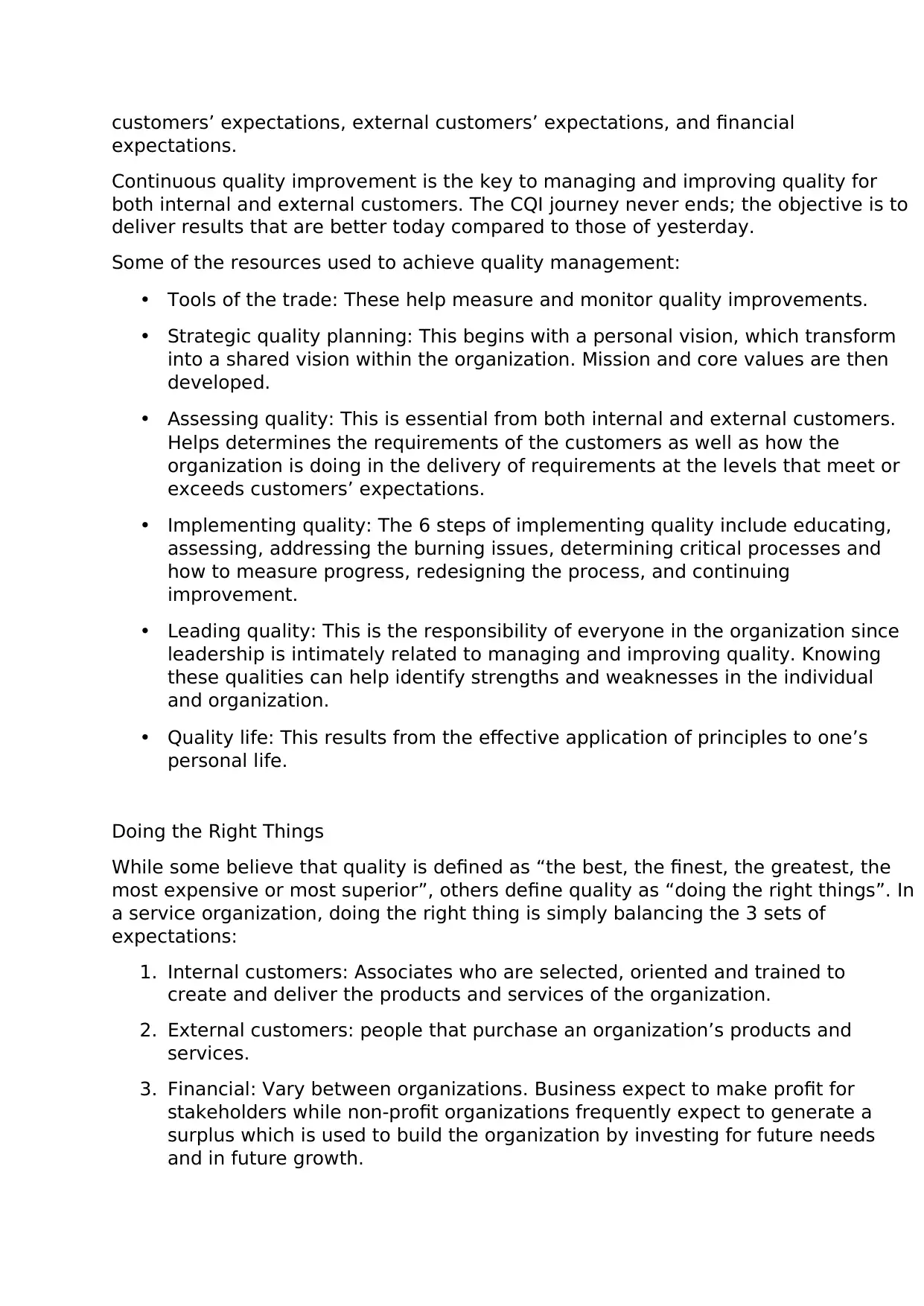
customers’ expectations, external customers’ expectations, and financial
expectations.
Continuous quality improvement is the key to managing and improving quality for
both internal and external customers. The CQI journey never ends; the objective is to
deliver results that are better today compared to those of yesterday.
Some of the resources used to achieve quality management:
• Tools of the trade: These help measure and monitor quality improvements.
• Strategic quality planning: This begins with a personal vision, which transform
into a shared vision within the organization. Mission and core values are then
developed.
• Assessing quality: This is essential from both internal and external customers.
Helps determines the requirements of the customers as well as how the
organization is doing in the delivery of requirements at the levels that meet or
exceeds customers’ expectations.
• Implementing quality: The 6 steps of implementing quality include educating,
assessing, addressing the burning issues, determining critical processes and
how to measure progress, redesigning the process, and continuing
improvement.
• Leading quality: This is the responsibility of everyone in the organization since
leadership is intimately related to managing and improving quality. Knowing
these qualities can help identify strengths and weaknesses in the individual
and organization.
• Quality life: This results from the effective application of principles to one’s
personal life.
Doing the Right Things
While some believe that quality is defined as “the best, the finest, the greatest, the
most expensive or most superior”, others define quality as “doing the right things”. In
a service organization, doing the right thing is simply balancing the 3 sets of
expectations:
1. Internal customers: Associates who are selected, oriented and trained to
create and deliver the products and services of the organization.
2. External customers: people that purchase an organization’s products and
services.
3. Financial: Vary between organizations. Business expect to make profit for
stakeholders while non-profit organizations frequently expect to generate a
surplus which is used to build the organization by investing for future needs
and in future growth.
expectations.
Continuous quality improvement is the key to managing and improving quality for
both internal and external customers. The CQI journey never ends; the objective is to
deliver results that are better today compared to those of yesterday.
Some of the resources used to achieve quality management:
• Tools of the trade: These help measure and monitor quality improvements.
• Strategic quality planning: This begins with a personal vision, which transform
into a shared vision within the organization. Mission and core values are then
developed.
• Assessing quality: This is essential from both internal and external customers.
Helps determines the requirements of the customers as well as how the
organization is doing in the delivery of requirements at the levels that meet or
exceeds customers’ expectations.
• Implementing quality: The 6 steps of implementing quality include educating,
assessing, addressing the burning issues, determining critical processes and
how to measure progress, redesigning the process, and continuing
improvement.
• Leading quality: This is the responsibility of everyone in the organization since
leadership is intimately related to managing and improving quality. Knowing
these qualities can help identify strengths and weaknesses in the individual
and organization.
• Quality life: This results from the effective application of principles to one’s
personal life.
Doing the Right Things
While some believe that quality is defined as “the best, the finest, the greatest, the
most expensive or most superior”, others define quality as “doing the right things”. In
a service organization, doing the right thing is simply balancing the 3 sets of
expectations:
1. Internal customers: Associates who are selected, oriented and trained to
create and deliver the products and services of the organization.
2. External customers: people that purchase an organization’s products and
services.
3. Financial: Vary between organizations. Business expect to make profit for
stakeholders while non-profit organizations frequently expect to generate a
surplus which is used to build the organization by investing for future needs
and in future growth.
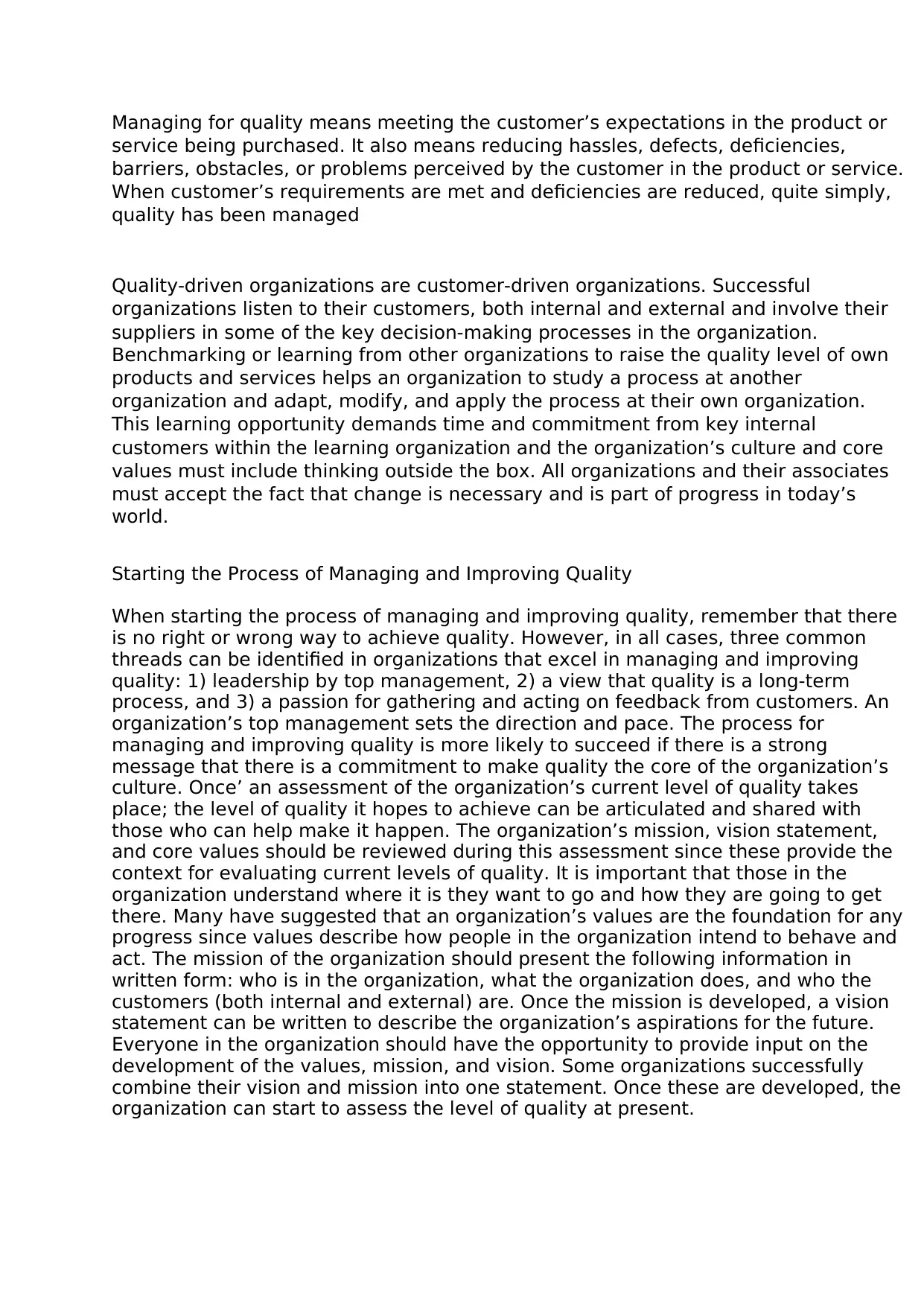
Managing for quality means meeting the customer’s expectations in the product or
service being purchased. It also means reducing hassles, defects, deficiencies,
barriers, obstacles, or problems perceived by the customer in the product or service.
When customer’s requirements are met and deficiencies are reduced, quite simply,
quality has been managed
Quality-driven organizations are customer-driven organizations. Successful
organizations listen to their customers, both internal and external and involve their
suppliers in some of the key decision-making processes in the organization.
Benchmarking or learning from other organizations to raise the quality level of own
products and services helps an organization to study a process at another
organization and adapt, modify, and apply the process at their own organization.
This learning opportunity demands time and commitment from key internal
customers within the learning organization and the organization’s culture and core
values must include thinking outside the box. All organizations and their associates
must accept the fact that change is necessary and is part of progress in today’s
world.
Starting the Process of Managing and Improving Quality
When starting the process of managing and improving quality, remember that there
is no right or wrong way to achieve quality. However, in all cases, three common
threads can be identified in organizations that excel in managing and improving
quality: 1) leadership by top management, 2) a view that quality is a long-term
process, and 3) a passion for gathering and acting on feedback from customers. An
organization’s top management sets the direction and pace. The process for
managing and improving quality is more likely to succeed if there is a strong
message that there is a commitment to make quality the core of the organization’s
culture. Once’ an assessment of the organization’s current level of quality takes
place; the level of quality it hopes to achieve can be articulated and shared with
those who can help make it happen. The organization’s mission, vision statement,
and core values should be reviewed during this assessment since these provide the
context for evaluating current levels of quality. It is important that those in the
organization understand where it is they want to go and how they are going to get
there. Many have suggested that an organization’s values are the foundation for any
progress since values describe how people in the organization intend to behave and
act. The mission of the organization should present the following information in
written form: who is in the organization, what the organization does, and who the
customers (both internal and external) are. Once the mission is developed, a vision
statement can be written to describe the organization’s aspirations for the future.
Everyone in the organization should have the opportunity to provide input on the
development of the values, mission, and vision. Some organizations successfully
combine their vision and mission into one statement. Once these are developed, the
organization can start to assess the level of quality at present.
service being purchased. It also means reducing hassles, defects, deficiencies,
barriers, obstacles, or problems perceived by the customer in the product or service.
When customer’s requirements are met and deficiencies are reduced, quite simply,
quality has been managed
Quality-driven organizations are customer-driven organizations. Successful
organizations listen to their customers, both internal and external and involve their
suppliers in some of the key decision-making processes in the organization.
Benchmarking or learning from other organizations to raise the quality level of own
products and services helps an organization to study a process at another
organization and adapt, modify, and apply the process at their own organization.
This learning opportunity demands time and commitment from key internal
customers within the learning organization and the organization’s culture and core
values must include thinking outside the box. All organizations and their associates
must accept the fact that change is necessary and is part of progress in today’s
world.
Starting the Process of Managing and Improving Quality
When starting the process of managing and improving quality, remember that there
is no right or wrong way to achieve quality. However, in all cases, three common
threads can be identified in organizations that excel in managing and improving
quality: 1) leadership by top management, 2) a view that quality is a long-term
process, and 3) a passion for gathering and acting on feedback from customers. An
organization’s top management sets the direction and pace. The process for
managing and improving quality is more likely to succeed if there is a strong
message that there is a commitment to make quality the core of the organization’s
culture. Once’ an assessment of the organization’s current level of quality takes
place; the level of quality it hopes to achieve can be articulated and shared with
those who can help make it happen. The organization’s mission, vision statement,
and core values should be reviewed during this assessment since these provide the
context for evaluating current levels of quality. It is important that those in the
organization understand where it is they want to go and how they are going to get
there. Many have suggested that an organization’s values are the foundation for any
progress since values describe how people in the organization intend to behave and
act. The mission of the organization should present the following information in
written form: who is in the organization, what the organization does, and who the
customers (both internal and external) are. Once the mission is developed, a vision
statement can be written to describe the organization’s aspirations for the future.
Everyone in the organization should have the opportunity to provide input on the
development of the values, mission, and vision. Some organizations successfully
combine their vision and mission into one statement. Once these are developed, the
organization can start to assess the level of quality at present.
⊘ This is a preview!⊘
Do you want full access?
Subscribe today to unlock all pages.

Trusted by 1+ million students worldwide
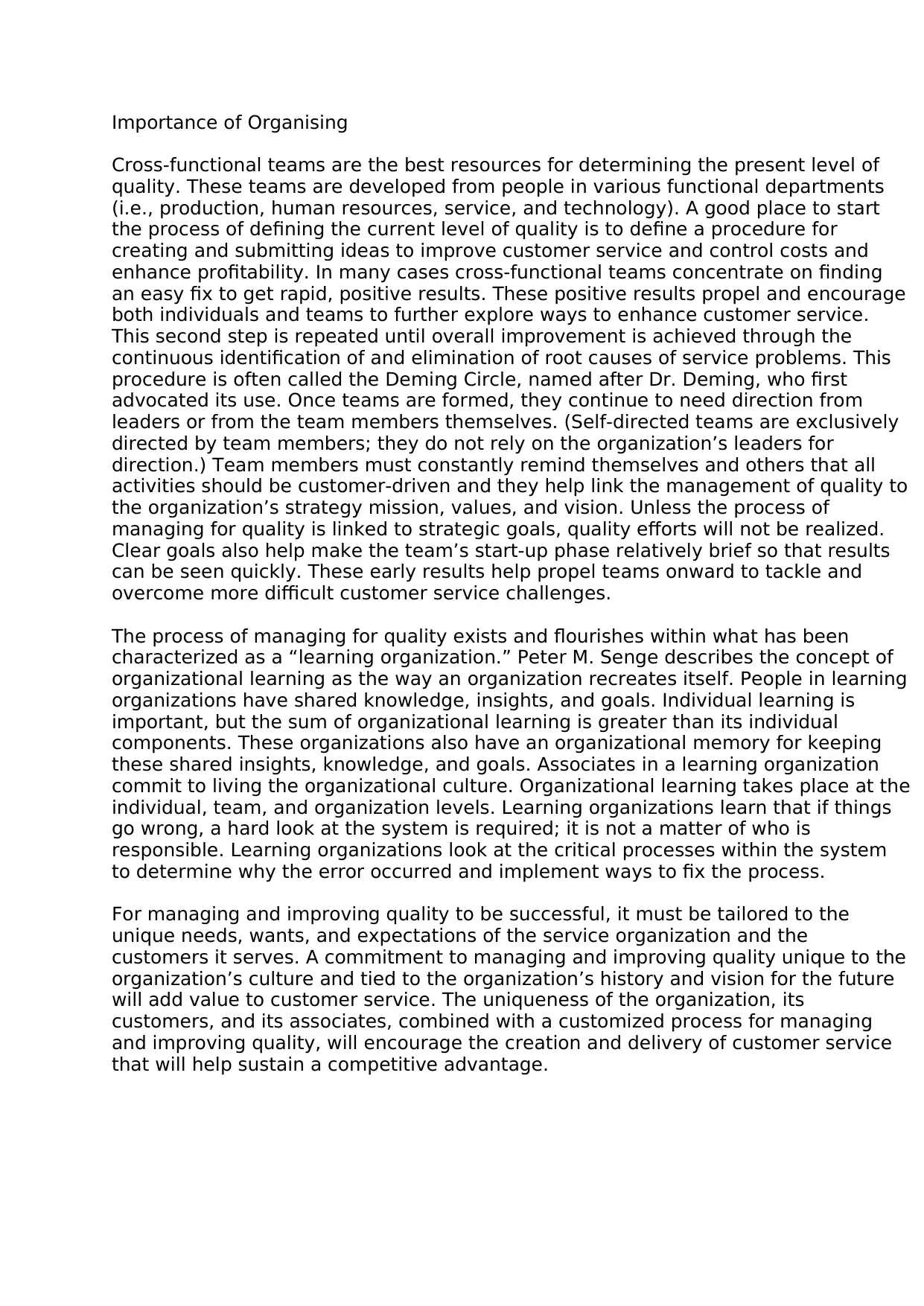
Importance of Organising
Cross-functional teams are the best resources for determining the present level of
quality. These teams are developed from people in various functional departments
(i.e., production, human resources, service, and technology). A good place to start
the process of defining the current level of quality is to define a procedure for
creating and submitting ideas to improve customer service and control costs and
enhance profitability. In many cases cross-functional teams concentrate on finding
an easy fix to get rapid, positive results. These positive results propel and encourage
both individuals and teams to further explore ways to enhance customer service.
This second step is repeated until overall improvement is achieved through the
continuous identification of and elimination of root causes of service problems. This
procedure is often called the Deming Circle, named after Dr. Deming, who first
advocated its use. Once teams are formed, they continue to need direction from
leaders or from the team members themselves. (Self-directed teams are exclusively
directed by team members; they do not rely on the organization’s leaders for
direction.) Team members must constantly remind themselves and others that all
activities should be customer-driven and they help link the management of quality to
the organization’s strategy mission, values, and vision. Unless the process of
managing for quality is linked to strategic goals, quality efforts will not be realized.
Clear goals also help make the team’s start-up phase relatively brief so that results
can be seen quickly. These early results help propel teams onward to tackle and
overcome more difficult customer service challenges.
The process of managing for quality exists and flourishes within what has been
characterized as a “learning organization.” Peter M. Senge describes the concept of
organizational learning as the way an organization recreates itself. People in learning
organizations have shared knowledge, insights, and goals. Individual learning is
important, but the sum of organizational learning is greater than its individual
components. These organizations also have an organizational memory for keeping
these shared insights, knowledge, and goals. Associates in a learning organization
commit to living the organizational culture. Organizational learning takes place at the
individual, team, and organization levels. Learning organizations learn that if things
go wrong, a hard look at the system is required; it is not a matter of who is
responsible. Learning organizations look at the critical processes within the system
to determine why the error occurred and implement ways to fix the process.
For managing and improving quality to be successful, it must be tailored to the
unique needs, wants, and expectations of the service organization and the
customers it serves. A commitment to managing and improving quality unique to the
organization’s culture and tied to the organization’s history and vision for the future
will add value to customer service. The uniqueness of the organization, its
customers, and its associates, combined with a customized process for managing
and improving quality, will encourage the creation and delivery of customer service
that will help sustain a competitive advantage.
Cross-functional teams are the best resources for determining the present level of
quality. These teams are developed from people in various functional departments
(i.e., production, human resources, service, and technology). A good place to start
the process of defining the current level of quality is to define a procedure for
creating and submitting ideas to improve customer service and control costs and
enhance profitability. In many cases cross-functional teams concentrate on finding
an easy fix to get rapid, positive results. These positive results propel and encourage
both individuals and teams to further explore ways to enhance customer service.
This second step is repeated until overall improvement is achieved through the
continuous identification of and elimination of root causes of service problems. This
procedure is often called the Deming Circle, named after Dr. Deming, who first
advocated its use. Once teams are formed, they continue to need direction from
leaders or from the team members themselves. (Self-directed teams are exclusively
directed by team members; they do not rely on the organization’s leaders for
direction.) Team members must constantly remind themselves and others that all
activities should be customer-driven and they help link the management of quality to
the organization’s strategy mission, values, and vision. Unless the process of
managing for quality is linked to strategic goals, quality efforts will not be realized.
Clear goals also help make the team’s start-up phase relatively brief so that results
can be seen quickly. These early results help propel teams onward to tackle and
overcome more difficult customer service challenges.
The process of managing for quality exists and flourishes within what has been
characterized as a “learning organization.” Peter M. Senge describes the concept of
organizational learning as the way an organization recreates itself. People in learning
organizations have shared knowledge, insights, and goals. Individual learning is
important, but the sum of organizational learning is greater than its individual
components. These organizations also have an organizational memory for keeping
these shared insights, knowledge, and goals. Associates in a learning organization
commit to living the organizational culture. Organizational learning takes place at the
individual, team, and organization levels. Learning organizations learn that if things
go wrong, a hard look at the system is required; it is not a matter of who is
responsible. Learning organizations look at the critical processes within the system
to determine why the error occurred and implement ways to fix the process.
For managing and improving quality to be successful, it must be tailored to the
unique needs, wants, and expectations of the service organization and the
customers it serves. A commitment to managing and improving quality unique to the
organization’s culture and tied to the organization’s history and vision for the future
will add value to customer service. The uniqueness of the organization, its
customers, and its associates, combined with a customized process for managing
and improving quality, will encourage the creation and delivery of customer service
that will help sustain a competitive advantage.
Paraphrase This Document
Need a fresh take? Get an instant paraphrase of this document with our AI Paraphraser
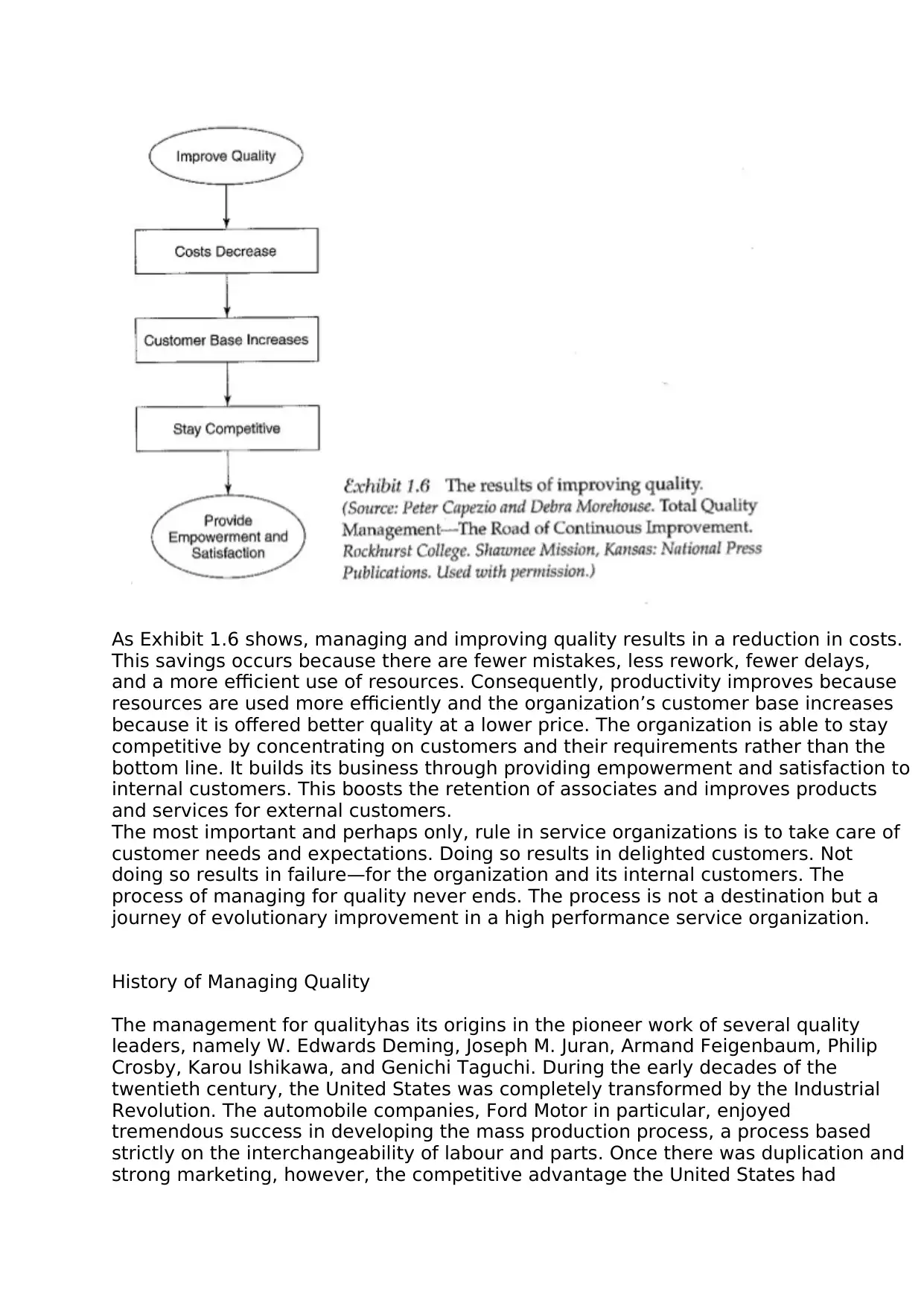
As Exhibit 1.6 shows, managing and improving quality results in a reduction in costs.
This savings occurs because there are fewer mistakes, less rework, fewer delays,
and a more efficient use of resources. Consequently, productivity improves because
resources are used more efficiently and the organization’s customer base increases
because it is offered better quality at a lower price. The organization is able to stay
competitive by concentrating on customers and their requirements rather than the
bottom line. It builds its business through providing empowerment and satisfaction to
internal customers. This boosts the retention of associates and improves products
and services for external customers.
The most important and perhaps only, rule in service organizations is to take care of
customer needs and expectations. Doing so results in delighted customers. Not
doing so results in failure—for the organization and its internal customers. The
process of managing for quality never ends. The process is not a destination but a
journey of evolutionary improvement in a high performance service organization.
History of Managing Quality
The management for qualityhas its origins in the pioneer work of several quality
leaders, namely W. Edwards Deming, Joseph M. Juran, Armand Feigenbaum, Philip
Crosby, Karou Ishikawa, and Genichi Taguchi. During the early decades of the
twentieth century, the United States was completely transformed by the Industrial
Revolution. The automobile companies, Ford Motor in particular, enjoyed
tremendous success in developing the mass production process, a process based
strictly on the interchangeability of labour and parts. Once there was duplication and
strong marketing, however, the competitive advantage the United States had
This savings occurs because there are fewer mistakes, less rework, fewer delays,
and a more efficient use of resources. Consequently, productivity improves because
resources are used more efficiently and the organization’s customer base increases
because it is offered better quality at a lower price. The organization is able to stay
competitive by concentrating on customers and their requirements rather than the
bottom line. It builds its business through providing empowerment and satisfaction to
internal customers. This boosts the retention of associates and improves products
and services for external customers.
The most important and perhaps only, rule in service organizations is to take care of
customer needs and expectations. Doing so results in delighted customers. Not
doing so results in failure—for the organization and its internal customers. The
process of managing for quality never ends. The process is not a destination but a
journey of evolutionary improvement in a high performance service organization.
History of Managing Quality
The management for qualityhas its origins in the pioneer work of several quality
leaders, namely W. Edwards Deming, Joseph M. Juran, Armand Feigenbaum, Philip
Crosby, Karou Ishikawa, and Genichi Taguchi. During the early decades of the
twentieth century, the United States was completely transformed by the Industrial
Revolution. The automobile companies, Ford Motor in particular, enjoyed
tremendous success in developing the mass production process, a process based
strictly on the interchangeability of labour and parts. Once there was duplication and
strong marketing, however, the competitive advantage the United States had
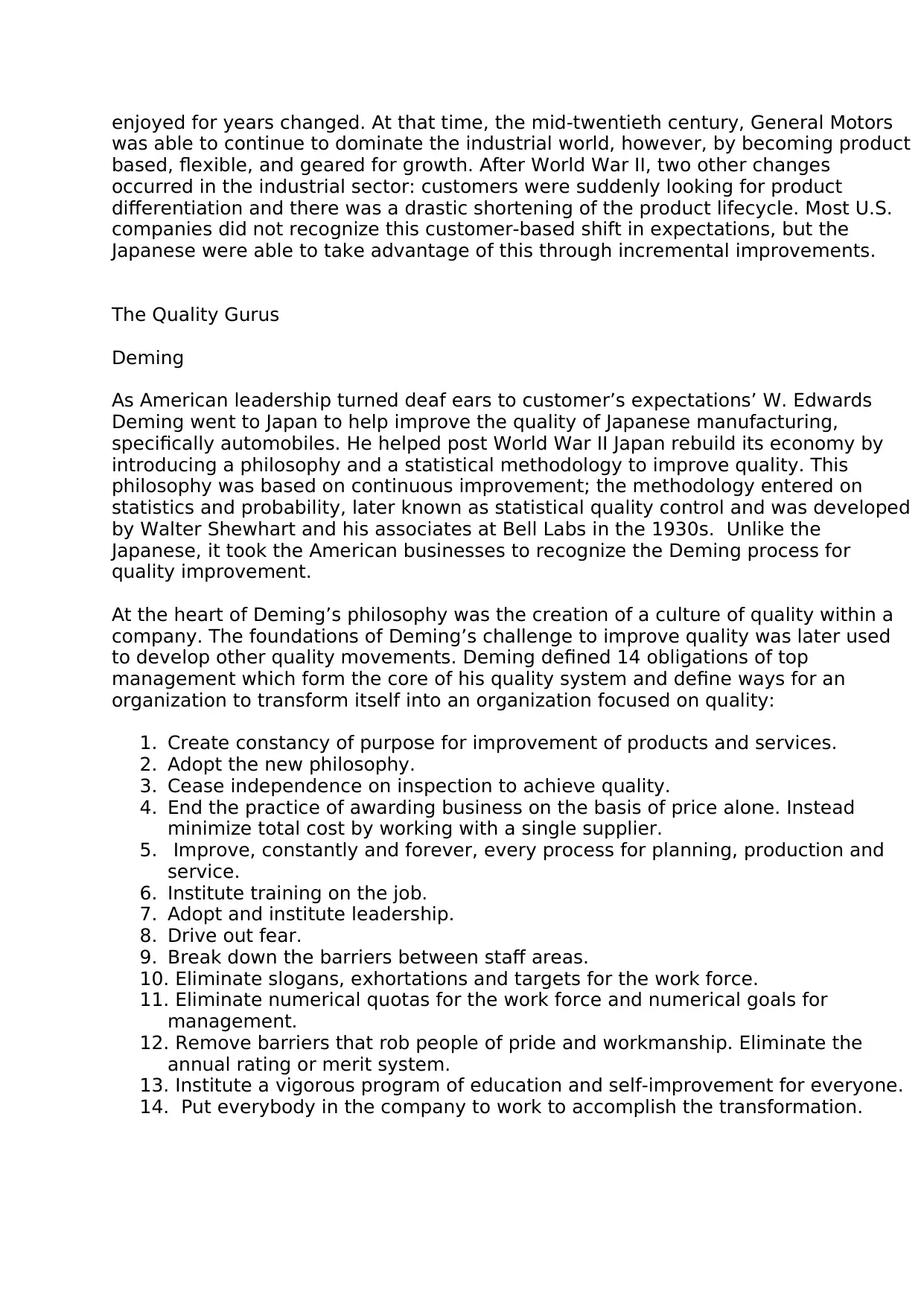
enjoyed for years changed. At that time, the mid-twentieth century, General Motors
was able to continue to dominate the industrial world, however, by becoming product
based, flexible, and geared for growth. After World War II, two other changes
occurred in the industrial sector: customers were suddenly looking for product
differentiation and there was a drastic shortening of the product lifecycle. Most U.S.
companies did not recognize this customer-based shift in expectations, but the
Japanese were able to take advantage of this through incremental improvements.
The Quality Gurus
Deming
As American leadership turned deaf ears to customer’s expectations’ W. Edwards
Deming went to Japan to help improve the quality of Japanese manufacturing,
specifically automobiles. He helped post World War II Japan rebuild its economy by
introducing a philosophy and a statistical methodology to improve quality. This
philosophy was based on continuous improvement; the methodology entered on
statistics and probability, later known as statistical quality control and was developed
by Walter Shewhart and his associates at Bell Labs in the 1930s. Unlike the
Japanese, it took the American businesses to recognize the Deming process for
quality improvement.
At the heart of Deming’s philosophy was the creation of a culture of quality within a
company. The foundations of Deming’s challenge to improve quality was later used
to develop other quality movements. Deming defined 14 obligations of top
management which form the core of his quality system and define ways for an
organization to transform itself into an organization focused on quality:
1. Create constancy of purpose for improvement of products and services.
2. Adopt the new philosophy.
3. Cease independence on inspection to achieve quality.
4. End the practice of awarding business on the basis of price alone. Instead
minimize total cost by working with a single supplier.
5. Improve, constantly and forever, every process for planning, production and
service.
6. Institute training on the job.
7. Adopt and institute leadership.
8. Drive out fear.
9. Break down the barriers between staff areas.
10. Eliminate slogans, exhortations and targets for the work force.
11. Eliminate numerical quotas for the work force and numerical goals for
management.
12. Remove barriers that rob people of pride and workmanship. Eliminate the
annual rating or merit system.
13. Institute a vigorous program of education and self-improvement for everyone.
14. Put everybody in the company to work to accomplish the transformation.
was able to continue to dominate the industrial world, however, by becoming product
based, flexible, and geared for growth. After World War II, two other changes
occurred in the industrial sector: customers were suddenly looking for product
differentiation and there was a drastic shortening of the product lifecycle. Most U.S.
companies did not recognize this customer-based shift in expectations, but the
Japanese were able to take advantage of this through incremental improvements.
The Quality Gurus
Deming
As American leadership turned deaf ears to customer’s expectations’ W. Edwards
Deming went to Japan to help improve the quality of Japanese manufacturing,
specifically automobiles. He helped post World War II Japan rebuild its economy by
introducing a philosophy and a statistical methodology to improve quality. This
philosophy was based on continuous improvement; the methodology entered on
statistics and probability, later known as statistical quality control and was developed
by Walter Shewhart and his associates at Bell Labs in the 1930s. Unlike the
Japanese, it took the American businesses to recognize the Deming process for
quality improvement.
At the heart of Deming’s philosophy was the creation of a culture of quality within a
company. The foundations of Deming’s challenge to improve quality was later used
to develop other quality movements. Deming defined 14 obligations of top
management which form the core of his quality system and define ways for an
organization to transform itself into an organization focused on quality:
1. Create constancy of purpose for improvement of products and services.
2. Adopt the new philosophy.
3. Cease independence on inspection to achieve quality.
4. End the practice of awarding business on the basis of price alone. Instead
minimize total cost by working with a single supplier.
5. Improve, constantly and forever, every process for planning, production and
service.
6. Institute training on the job.
7. Adopt and institute leadership.
8. Drive out fear.
9. Break down the barriers between staff areas.
10. Eliminate slogans, exhortations and targets for the work force.
11. Eliminate numerical quotas for the work force and numerical goals for
management.
12. Remove barriers that rob people of pride and workmanship. Eliminate the
annual rating or merit system.
13. Institute a vigorous program of education and self-improvement for everyone.
14. Put everybody in the company to work to accomplish the transformation.
⊘ This is a preview!⊘
Do you want full access?
Subscribe today to unlock all pages.

Trusted by 1+ million students worldwide
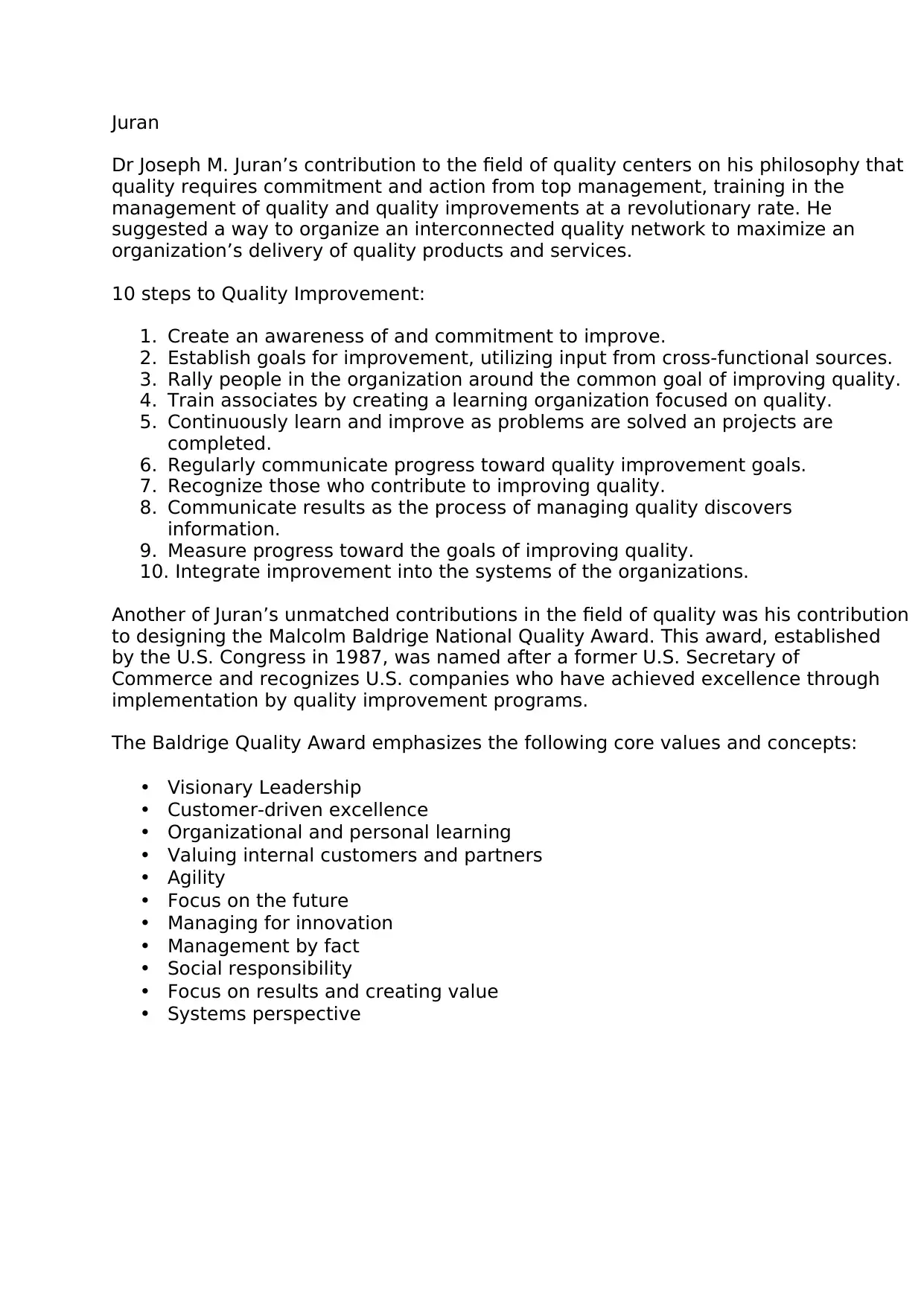
Juran
Dr Joseph M. Juran’s contribution to the field of quality centers on his philosophy that
quality requires commitment and action from top management, training in the
management of quality and quality improvements at a revolutionary rate. He
suggested a way to organize an interconnected quality network to maximize an
organization’s delivery of quality products and services.
10 steps to Quality Improvement:
1. Create an awareness of and commitment to improve.
2. Establish goals for improvement, utilizing input from cross-functional sources.
3. Rally people in the organization around the common goal of improving quality.
4. Train associates by creating a learning organization focused on quality.
5. Continuously learn and improve as problems are solved an projects are
completed.
6. Regularly communicate progress toward quality improvement goals.
7. Recognize those who contribute to improving quality.
8. Communicate results as the process of managing quality discovers
information.
9. Measure progress toward the goals of improving quality.
10. Integrate improvement into the systems of the organizations.
Another of Juran’s unmatched contributions in the field of quality was his contribution
to designing the Malcolm Baldrige National Quality Award. This award, established
by the U.S. Congress in 1987, was named after a former U.S. Secretary of
Commerce and recognizes U.S. companies who have achieved excellence through
implementation by quality improvement programs.
The Baldrige Quality Award emphasizes the following core values and concepts:
• Visionary Leadership
• Customer-driven excellence
• Organizational and personal learning
• Valuing internal customers and partners
• Agility
• Focus on the future
• Managing for innovation
• Management by fact
• Social responsibility
• Focus on results and creating value
• Systems perspective
Dr Joseph M. Juran’s contribution to the field of quality centers on his philosophy that
quality requires commitment and action from top management, training in the
management of quality and quality improvements at a revolutionary rate. He
suggested a way to organize an interconnected quality network to maximize an
organization’s delivery of quality products and services.
10 steps to Quality Improvement:
1. Create an awareness of and commitment to improve.
2. Establish goals for improvement, utilizing input from cross-functional sources.
3. Rally people in the organization around the common goal of improving quality.
4. Train associates by creating a learning organization focused on quality.
5. Continuously learn and improve as problems are solved an projects are
completed.
6. Regularly communicate progress toward quality improvement goals.
7. Recognize those who contribute to improving quality.
8. Communicate results as the process of managing quality discovers
information.
9. Measure progress toward the goals of improving quality.
10. Integrate improvement into the systems of the organizations.
Another of Juran’s unmatched contributions in the field of quality was his contribution
to designing the Malcolm Baldrige National Quality Award. This award, established
by the U.S. Congress in 1987, was named after a former U.S. Secretary of
Commerce and recognizes U.S. companies who have achieved excellence through
implementation by quality improvement programs.
The Baldrige Quality Award emphasizes the following core values and concepts:
• Visionary Leadership
• Customer-driven excellence
• Organizational and personal learning
• Valuing internal customers and partners
• Agility
• Focus on the future
• Managing for innovation
• Management by fact
• Social responsibility
• Focus on results and creating value
• Systems perspective
Paraphrase This Document
Need a fresh take? Get an instant paraphrase of this document with our AI Paraphraser
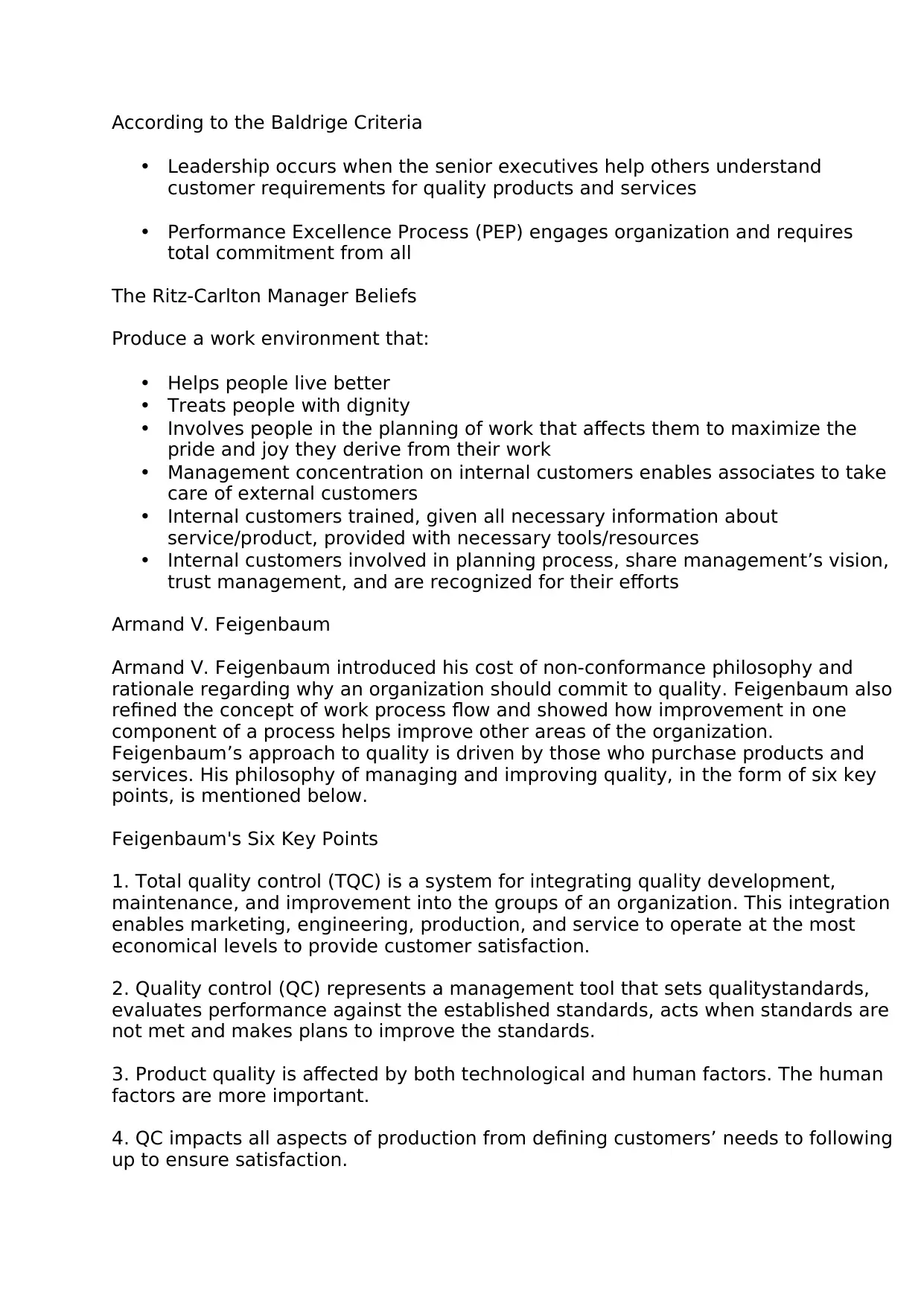
According to the Baldrige Criteria
• Leadership occurs when the senior executives help others understand
customer requirements for quality products and services
• Performance Excellence Process (PEP) engages organization and requires
total commitment from all
The Ritz-Carlton Manager Beliefs
Produce a work environment that:
• Helps people live better
• Treats people with dignity
• Involves people in the planning of work that affects them to maximize the
pride and joy they derive from their work
• Management concentration on internal customers enables associates to take
care of external customers
• Internal customers trained, given all necessary information about
service/product, provided with necessary tools/resources
• Internal customers involved in planning process, share management’s vision,
trust management, and are recognized for their efforts
Armand V. Feigenbaum
Armand V. Feigenbaum introduced his cost of non-conformance philosophy and
rationale regarding why an organization should commit to quality. Feigenbaum also
refined the concept of work process flow and showed how improvement in one
component of a process helps improve other areas of the organization.
Feigenbaum’s approach to quality is driven by those who purchase products and
services. His philosophy of managing and improving quality, in the form of six key
points, is mentioned below.
Feigenbaum's Six Key Points
1. Total quality control (TQC) is a system for integrating quality development,
maintenance, and improvement into the groups of an organization. This integration
enables marketing, engineering, production, and service to operate at the most
economical levels to provide customer satisfaction.
2. Quality control (QC) represents a management tool that sets qualitystandards,
evaluates performance against the established standards, acts when standards are
not met and makes plans to improve the standards.
3. Product quality is affected by both technological and human factors. The human
factors are more important.
4. QC impacts all aspects of production from defining customers’ needs to following
up to ensure satisfaction.
• Leadership occurs when the senior executives help others understand
customer requirements for quality products and services
• Performance Excellence Process (PEP) engages organization and requires
total commitment from all
The Ritz-Carlton Manager Beliefs
Produce a work environment that:
• Helps people live better
• Treats people with dignity
• Involves people in the planning of work that affects them to maximize the
pride and joy they derive from their work
• Management concentration on internal customers enables associates to take
care of external customers
• Internal customers trained, given all necessary information about
service/product, provided with necessary tools/resources
• Internal customers involved in planning process, share management’s vision,
trust management, and are recognized for their efforts
Armand V. Feigenbaum
Armand V. Feigenbaum introduced his cost of non-conformance philosophy and
rationale regarding why an organization should commit to quality. Feigenbaum also
refined the concept of work process flow and showed how improvement in one
component of a process helps improve other areas of the organization.
Feigenbaum’s approach to quality is driven by those who purchase products and
services. His philosophy of managing and improving quality, in the form of six key
points, is mentioned below.
Feigenbaum's Six Key Points
1. Total quality control (TQC) is a system for integrating quality development,
maintenance, and improvement into the groups of an organization. This integration
enables marketing, engineering, production, and service to operate at the most
economical levels to provide customer satisfaction.
2. Quality control (QC) represents a management tool that sets qualitystandards,
evaluates performance against the established standards, acts when standards are
not met and makes plans to improve the standards.
3. Product quality is affected by both technological and human factors. The human
factors are more important.
4. QC impacts all aspects of production from defining customers’ needs to following
up to ensure satisfaction.
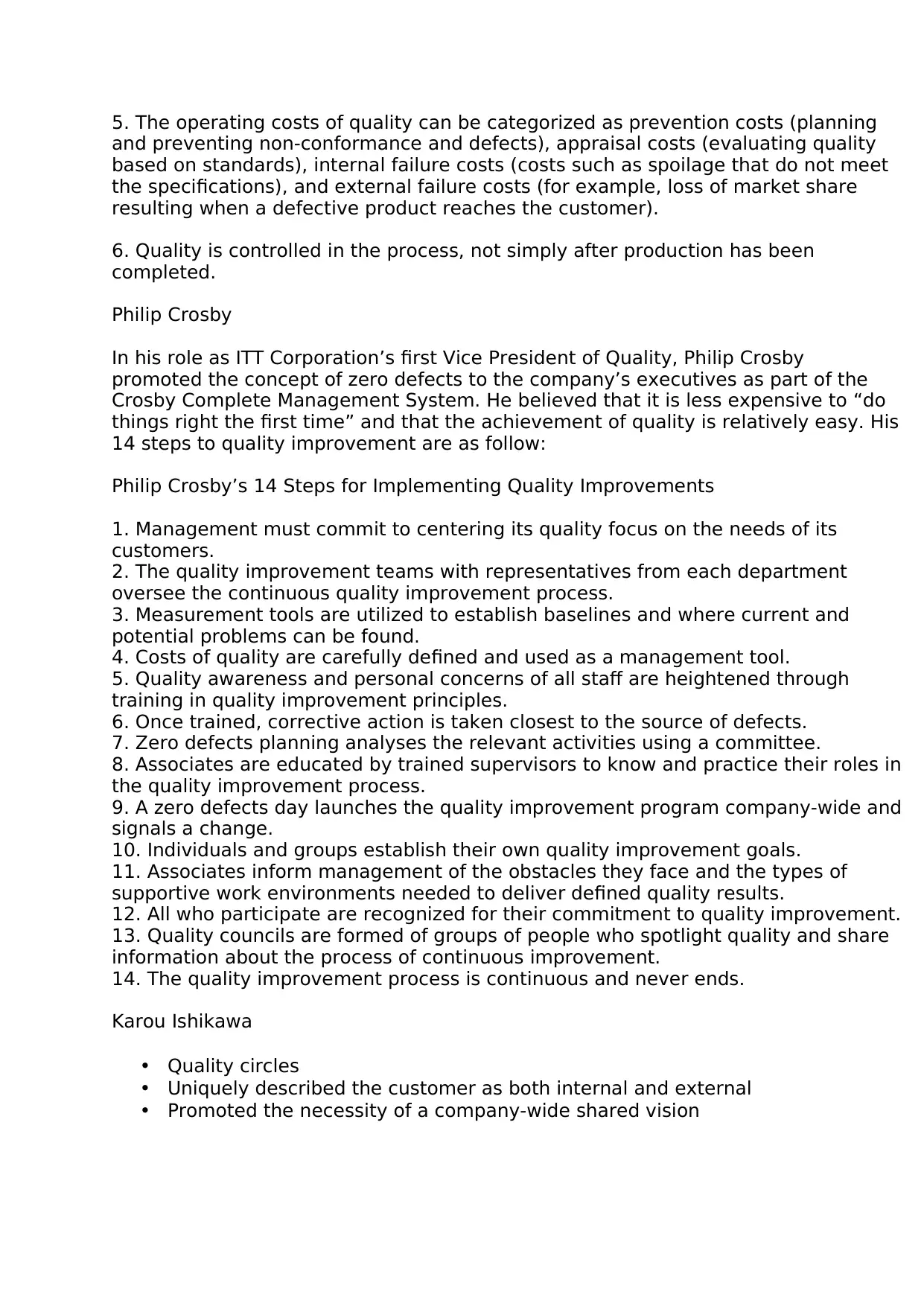
5. The operating costs of quality can be categorized as prevention costs (planning
and preventing non-conformance and defects), appraisal costs (evaluating quality
based on standards), internal failure costs (costs such as spoilage that do not meet
the specifications), and external failure costs (for example, loss of market share
resulting when a defective product reaches the customer).
6. Quality is controlled in the process, not simply after production has been
completed.
Philip Crosby
In his role as ITT Corporation’s first Vice President of Quality, Philip Crosby
promoted the concept of zero defects to the company’s executives as part of the
Crosby Complete Management System. He believed that it is less expensive to “do
things right the first time” and that the achievement of quality is relatively easy. His
14 steps to quality improvement are as follow:
Philip Crosby’s 14 Steps for Implementing Quality Improvements
1. Management must commit to centering its quality focus on the needs of its
customers.
2. The quality improvement teams with representatives from each department
oversee the continuous quality improvement process.
3. Measurement tools are utilized to establish baselines and where current and
potential problems can be found.
4. Costs of quality are carefully defined and used as a management tool.
5. Quality awareness and personal concerns of all staff are heightened through
training in quality improvement principles.
6. Once trained, corrective action is taken closest to the source of defects.
7. Zero defects planning analyses the relevant activities using a committee.
8. Associates are educated by trained supervisors to know and practice their roles in
the quality improvement process.
9. A zero defects day launches the quality improvement program company-wide and
signals a change.
10. Individuals and groups establish their own quality improvement goals.
11. Associates inform management of the obstacles they face and the types of
supportive work environments needed to deliver defined quality results.
12. All who participate are recognized for their commitment to quality improvement.
13. Quality councils are formed of groups of people who spotlight quality and share
information about the process of continuous improvement.
14. The quality improvement process is continuous and never ends.
Karou Ishikawa
• Quality circles
• Uniquely described the customer as both internal and external
• Promoted the necessity of a company-wide shared vision
and preventing non-conformance and defects), appraisal costs (evaluating quality
based on standards), internal failure costs (costs such as spoilage that do not meet
the specifications), and external failure costs (for example, loss of market share
resulting when a defective product reaches the customer).
6. Quality is controlled in the process, not simply after production has been
completed.
Philip Crosby
In his role as ITT Corporation’s first Vice President of Quality, Philip Crosby
promoted the concept of zero defects to the company’s executives as part of the
Crosby Complete Management System. He believed that it is less expensive to “do
things right the first time” and that the achievement of quality is relatively easy. His
14 steps to quality improvement are as follow:
Philip Crosby’s 14 Steps for Implementing Quality Improvements
1. Management must commit to centering its quality focus on the needs of its
customers.
2. The quality improvement teams with representatives from each department
oversee the continuous quality improvement process.
3. Measurement tools are utilized to establish baselines and where current and
potential problems can be found.
4. Costs of quality are carefully defined and used as a management tool.
5. Quality awareness and personal concerns of all staff are heightened through
training in quality improvement principles.
6. Once trained, corrective action is taken closest to the source of defects.
7. Zero defects planning analyses the relevant activities using a committee.
8. Associates are educated by trained supervisors to know and practice their roles in
the quality improvement process.
9. A zero defects day launches the quality improvement program company-wide and
signals a change.
10. Individuals and groups establish their own quality improvement goals.
11. Associates inform management of the obstacles they face and the types of
supportive work environments needed to deliver defined quality results.
12. All who participate are recognized for their commitment to quality improvement.
13. Quality councils are formed of groups of people who spotlight quality and share
information about the process of continuous improvement.
14. The quality improvement process is continuous and never ends.
Karou Ishikawa
• Quality circles
• Uniquely described the customer as both internal and external
• Promoted the necessity of a company-wide shared vision
⊘ This is a preview!⊘
Do you want full access?
Subscribe today to unlock all pages.

Trusted by 1+ million students worldwide
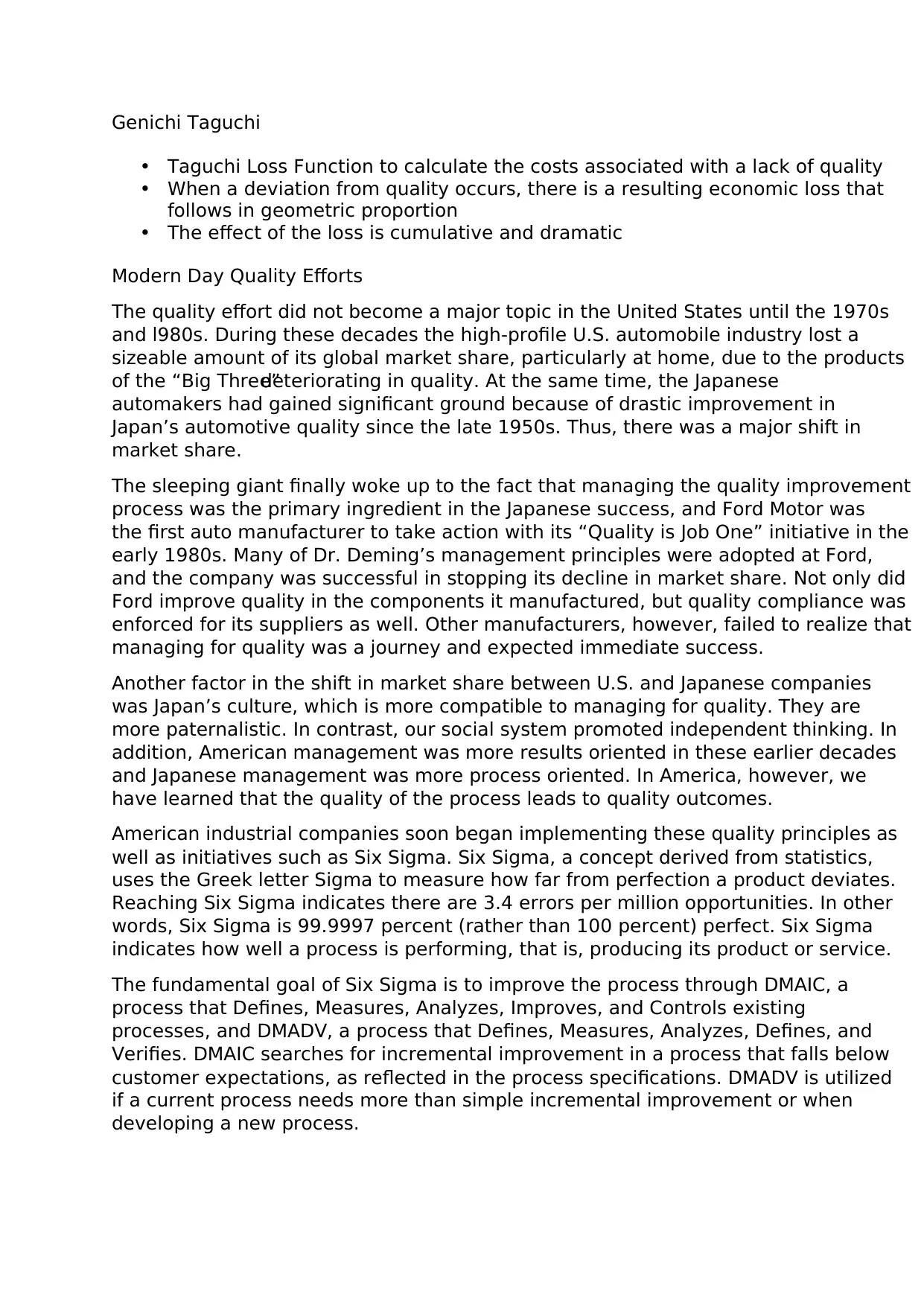
Genichi Taguchi
• Taguchi Loss Function to calculate the costs associated with a lack of quality
• When a deviation from quality occurs, there is a resulting economic loss that
follows in geometric proportion
• The effect of the loss is cumulative and dramatic
Modern Day Quality Efforts
The quality effort did not become a major topic in the United States until the 1970s
and l980s. During these decades the high-profile U.S. automobile industry lost a
sizeable amount of its global market share, particularly at home, due to the products
of the “Big Three”deteriorating in quality. At the same time, the Japanese
automakers had gained significant ground because of drastic improvement in
Japan’s automotive quality since the late 1950s. Thus, there was a major shift in
market share.
The sleeping giant finally woke up to the fact that managing the quality improvement
process was the primary ingredient in the Japanese success, and Ford Motor was
the first auto manufacturer to take action with its “Quality is Job One” initiative in the
early 1980s. Many of Dr. Deming’s management principles were adopted at Ford,
and the company was successful in stopping its decline in market share. Not only did
Ford improve quality in the components it manufactured, but quality compliance was
enforced for its suppliers as well. Other manufacturers, however, failed to realize that
managing for quality was a journey and expected immediate success.
Another factor in the shift in market share between U.S. and Japanese companies
was Japan’s culture, which is more compatible to managing for quality. They are
more paternalistic. In contrast, our social system promoted independent thinking. In
addition, American management was more results oriented in these earlier decades
and Japanese management was more process oriented. In America, however, we
have learned that the quality of the process leads to quality outcomes.
American industrial companies soon began implementing these quality principles as
well as initiatives such as Six Sigma. Six Sigma, a concept derived from statistics,
uses the Greek letter Sigma to measure how far from perfection a product deviates.
Reaching Six Sigma indicates there are 3.4 errors per million opportunities. In other
words, Six Sigma is 99.9997 percent (rather than 100 percent) perfect. Six Sigma
indicates how well a process is performing, that is, producing its product or service.
The fundamental goal of Six Sigma is to improve the process through DMAIC, a
process that Defines, Measures, Analyzes, Improves, and Controls existing
processes, and DMADV, a process that Defines, Measures, Analyzes, Defines, and
Verifies. DMAIC searches for incremental improvement in a process that falls below
customer expectations, as reflected in the process specifications. DMADV is utilized
if a current process needs more than simple incremental improvement or when
developing a new process.
• Taguchi Loss Function to calculate the costs associated with a lack of quality
• When a deviation from quality occurs, there is a resulting economic loss that
follows in geometric proportion
• The effect of the loss is cumulative and dramatic
Modern Day Quality Efforts
The quality effort did not become a major topic in the United States until the 1970s
and l980s. During these decades the high-profile U.S. automobile industry lost a
sizeable amount of its global market share, particularly at home, due to the products
of the “Big Three”deteriorating in quality. At the same time, the Japanese
automakers had gained significant ground because of drastic improvement in
Japan’s automotive quality since the late 1950s. Thus, there was a major shift in
market share.
The sleeping giant finally woke up to the fact that managing the quality improvement
process was the primary ingredient in the Japanese success, and Ford Motor was
the first auto manufacturer to take action with its “Quality is Job One” initiative in the
early 1980s. Many of Dr. Deming’s management principles were adopted at Ford,
and the company was successful in stopping its decline in market share. Not only did
Ford improve quality in the components it manufactured, but quality compliance was
enforced for its suppliers as well. Other manufacturers, however, failed to realize that
managing for quality was a journey and expected immediate success.
Another factor in the shift in market share between U.S. and Japanese companies
was Japan’s culture, which is more compatible to managing for quality. They are
more paternalistic. In contrast, our social system promoted independent thinking. In
addition, American management was more results oriented in these earlier decades
and Japanese management was more process oriented. In America, however, we
have learned that the quality of the process leads to quality outcomes.
American industrial companies soon began implementing these quality principles as
well as initiatives such as Six Sigma. Six Sigma, a concept derived from statistics,
uses the Greek letter Sigma to measure how far from perfection a product deviates.
Reaching Six Sigma indicates there are 3.4 errors per million opportunities. In other
words, Six Sigma is 99.9997 percent (rather than 100 percent) perfect. Six Sigma
indicates how well a process is performing, that is, producing its product or service.
The fundamental goal of Six Sigma is to improve the process through DMAIC, a
process that Defines, Measures, Analyzes, Improves, and Controls existing
processes, and DMADV, a process that Defines, Measures, Analyzes, Defines, and
Verifies. DMAIC searches for incremental improvement in a process that falls below
customer expectations, as reflected in the process specifications. DMADV is utilized
if a current process needs more than simple incremental improvement or when
developing a new process.
Paraphrase This Document
Need a fresh take? Get an instant paraphrase of this document with our AI Paraphraser
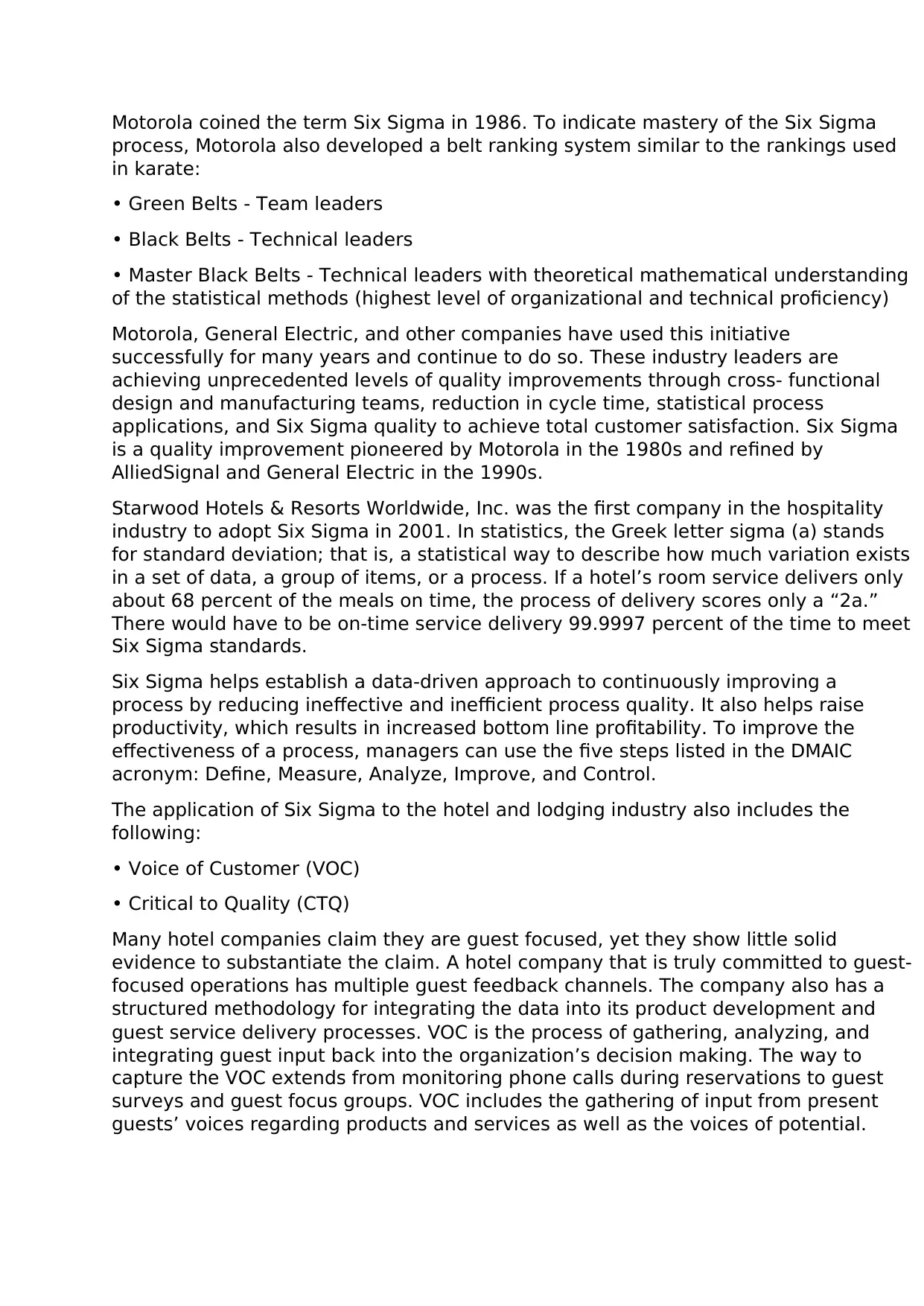
Motorola coined the term Six Sigma in 1986. To indicate mastery of the Six Sigma
process, Motorola also developed a belt ranking system similar to the rankings used
in karate:
• Green Belts - Team leaders
• Black Belts - Technical leaders
• Master Black Belts - Technical leaders with theoretical mathematical understanding
of the statistical methods (highest level of organizational and technical proficiency)
Motorola, General Electric, and other companies have used this initiative
successfully for many years and continue to do so. These industry leaders are
achieving unprecedented levels of quality improvements through cross- functional
design and manufacturing teams, reduction in cycle time, statistical process
applications, and Six Sigma quality to achieve total customer satisfaction. Six Sigma
is a quality improvement pioneered by Motorola in the 1980s and refined by
AlliedSignal and General Electric in the 1990s.
Starwood Hotels & Resorts Worldwide, Inc. was the first company in the hospitality
industry to adopt Six Sigma in 2001. In statistics, the Greek letter sigma (a) stands
for standard deviation; that is, a statistical way to describe how much variation exists
in a set of data, a group of items, or a process. If a hotel’s room service delivers only
about 68 percent of the meals on time, the process of delivery scores only a “2a.”
There would have to be on-time service delivery 99.9997 percent of the time to meet
Six Sigma standards.
Six Sigma helps establish a data-driven approach to continuously improving a
process by reducing ineffective and inefficient process quality. It also helps raise
productivity, which results in increased bottom line profitability. To improve the
effectiveness of a process, managers can use the five steps listed in the DMAIC
acronym: Define, Measure, Analyze, Improve, and Control.
The application of Six Sigma to the hotel and lodging industry also includes the
following:
• Voice of Customer (VOC)
• Critical to Quality (CTQ)
Many hotel companies claim they are guest focused, yet they show little solid
evidence to substantiate the claim. A hotel company that is truly committed to guest-
focused operations has multiple guest feedback channels. The company also has a
structured methodology for integrating the data into its product development and
guest service delivery processes. VOC is the process of gathering, analyzing, and
integrating guest input back into the organization’s decision making. The way to
capture the VOC extends from monitoring phone calls during reservations to guest
surveys and guest focus groups. VOC includes the gathering of input from present
guests’ voices regarding products and services as well as the voices of potential.
process, Motorola also developed a belt ranking system similar to the rankings used
in karate:
• Green Belts - Team leaders
• Black Belts - Technical leaders
• Master Black Belts - Technical leaders with theoretical mathematical understanding
of the statistical methods (highest level of organizational and technical proficiency)
Motorola, General Electric, and other companies have used this initiative
successfully for many years and continue to do so. These industry leaders are
achieving unprecedented levels of quality improvements through cross- functional
design and manufacturing teams, reduction in cycle time, statistical process
applications, and Six Sigma quality to achieve total customer satisfaction. Six Sigma
is a quality improvement pioneered by Motorola in the 1980s and refined by
AlliedSignal and General Electric in the 1990s.
Starwood Hotels & Resorts Worldwide, Inc. was the first company in the hospitality
industry to adopt Six Sigma in 2001. In statistics, the Greek letter sigma (a) stands
for standard deviation; that is, a statistical way to describe how much variation exists
in a set of data, a group of items, or a process. If a hotel’s room service delivers only
about 68 percent of the meals on time, the process of delivery scores only a “2a.”
There would have to be on-time service delivery 99.9997 percent of the time to meet
Six Sigma standards.
Six Sigma helps establish a data-driven approach to continuously improving a
process by reducing ineffective and inefficient process quality. It also helps raise
productivity, which results in increased bottom line profitability. To improve the
effectiveness of a process, managers can use the five steps listed in the DMAIC
acronym: Define, Measure, Analyze, Improve, and Control.
The application of Six Sigma to the hotel and lodging industry also includes the
following:
• Voice of Customer (VOC)
• Critical to Quality (CTQ)
Many hotel companies claim they are guest focused, yet they show little solid
evidence to substantiate the claim. A hotel company that is truly committed to guest-
focused operations has multiple guest feedback channels. The company also has a
structured methodology for integrating the data into its product development and
guest service delivery processes. VOC is the process of gathering, analyzing, and
integrating guest input back into the organization’s decision making. The way to
capture the VOC extends from monitoring phone calls during reservations to guest
surveys and guest focus groups. VOC includes the gathering of input from present
guests’ voices regarding products and services as well as the voices of potential.
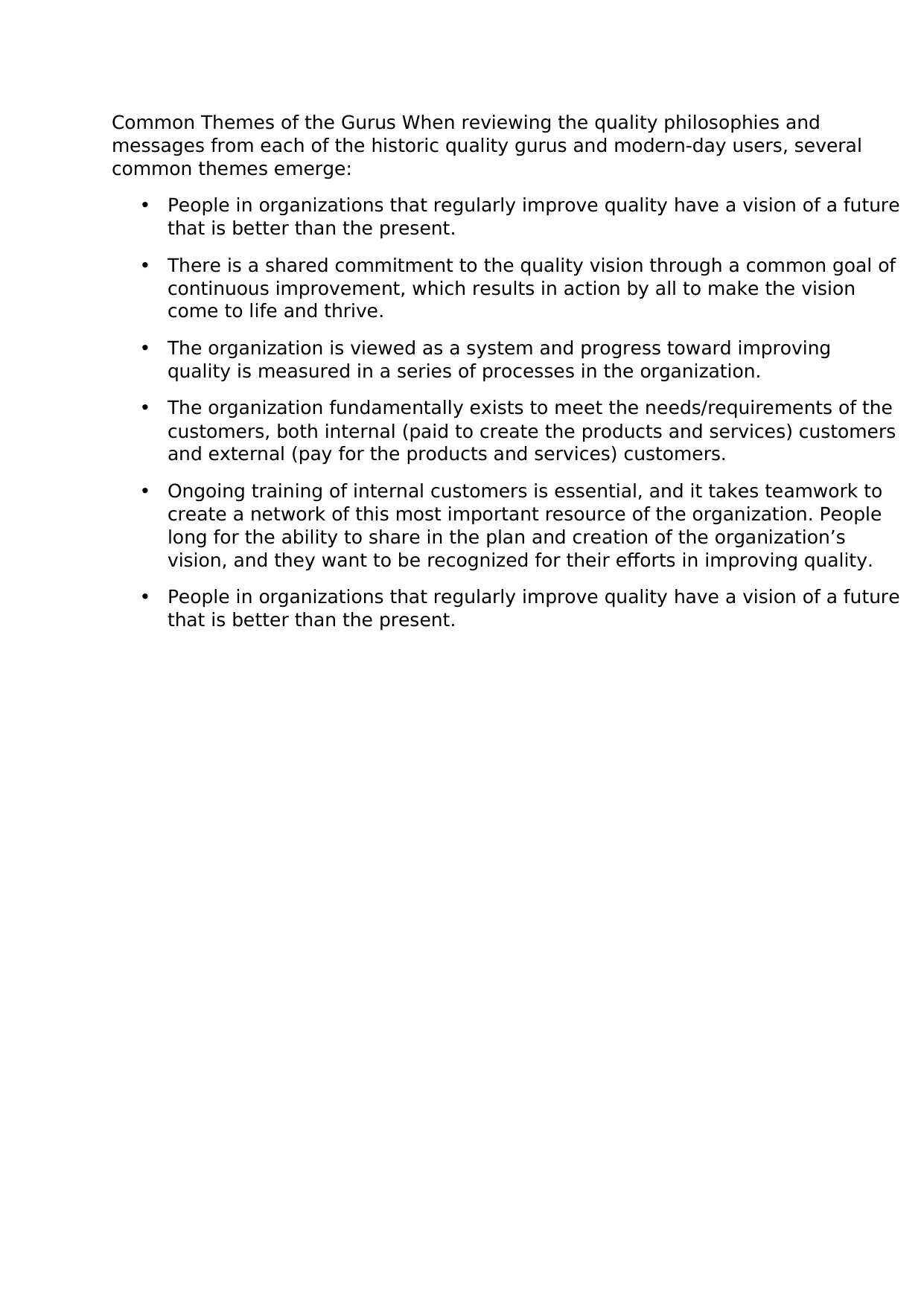
Common Themes of the Gurus When reviewing the quality philosophies and
messages from each of the historic quality gurus and modern-day users, several
common themes emerge:
• People in organizations that regularly improve quality have a vision of a future
that is better than the present.
• There is a shared commitment to the quality vision through a common goal of
continuous improvement, which results in action by all to make the vision
come to life and thrive.
• The organization is viewed as a system and progress toward improving
quality is measured in a series of processes in the organization.
• The organization fundamentally exists to meet the needs/requirements of the
customers, both internal (paid to create the products and services) customers
and external (pay for the products and services) customers.
• Ongoing training of internal customers is essential, and it takes teamwork to
create a network of this most important resource of the organization. People
long for the ability to share in the plan and creation of the organization’s
vision, and they want to be recognized for their efforts in improving quality.
• People in organizations that regularly improve quality have a vision of a future
that is better than the present.
messages from each of the historic quality gurus and modern-day users, several
common themes emerge:
• People in organizations that regularly improve quality have a vision of a future
that is better than the present.
• There is a shared commitment to the quality vision through a common goal of
continuous improvement, which results in action by all to make the vision
come to life and thrive.
• The organization is viewed as a system and progress toward improving
quality is measured in a series of processes in the organization.
• The organization fundamentally exists to meet the needs/requirements of the
customers, both internal (paid to create the products and services) customers
and external (pay for the products and services) customers.
• Ongoing training of internal customers is essential, and it takes teamwork to
create a network of this most important resource of the organization. People
long for the ability to share in the plan and creation of the organization’s
vision, and they want to be recognized for their efforts in improving quality.
• People in organizations that regularly improve quality have a vision of a future
that is better than the present.
⊘ This is a preview!⊘
Do you want full access?
Subscribe today to unlock all pages.

Trusted by 1+ million students worldwide
1 out of 63
Related Documents
Your All-in-One AI-Powered Toolkit for Academic Success.
+13062052269
info@desklib.com
Available 24*7 on WhatsApp / Email
![[object Object]](/_next/static/media/star-bottom.7253800d.svg)
Unlock your academic potential
Copyright © 2020–2025 A2Z Services. All Rights Reserved. Developed and managed by ZUCOL.





